
By Argeiphontes, July 29, 2019

A couple weeks into the expansion and one hotfix later, we are getting a clearer picture of the new Syndicate faction. Join Argeiphontes and Jamedi as they review every card in the Novigrad expansion.

Novigrad Expansion: Card Breakdown
At the start of the expansion, we streamed a live card review in two parts: Part 1 and Part 2.
This is our companion piece to the card review, updated with our thoughts after the hotfix. We will be rating each card on a 5-point scale with half steps:
5: Meta-defining (Glustyworp, Sheldon Skaggs, Svalblod Priest)
4: Archetype/faction staple(Svalblod Totem, Assire var Anahid, Lyrian Arbalest)
3: Role-player in certain decks (Royal Decree, Ancient Foglet, Cintrian Spellweaver)
2: Niche card (King Demavend III, Impenetrable Fog, Panther)
1: Unlikely to see competitive play (Ceallach Dyffryn, Mastercrafted Spear, Tuirseach Axeman)
The scale aims to evaluate card impact on the meta at the highest level of Pro Rank play. Due to the unique nature of Gwent's Pro Rank, which calculates MMR by adding together a player's top 4 faction scores, the majority of factions will see significant play. As such, particular emphasis is put on how a card stacks up compared to other cards in the same faction, though raw power is also considered.
In the spirit of the expansion, cards are split up by their gang affiliation.

 Rating: 3.5
Rating: 3.5
Tinboy is one of the high-provision finishers of the faction. It's like Lacerate with a body, which makes it excellent for long rounds. However, its Tribute is high and, much like Lacerate, it can get bled. If you are playing against swarm decks though, you can consider using it as a sort of offensive Yennefer of Vengerberg. This is one of the cards with the most potential in this expansion, but it remains to be seen where it will fall in the meta.
 Rating: 3.0
Rating: 3.0
Madame Luiza is an interesting card which can generally be used in two types of decks. The first has a main focus on high-cost Tributes, where it is used as a way to prepare our big Tribute cards such as Tinboy. The other is a hybrid Crime deck using its Intimidate ability while carrying some Tribute elements. Worth keeping an eye on.
 Rating: 2.5
Rating: 2.5
Adriano the Mink is a solid card in the worst of cases, in the general line of most of Syndicate cards, while also being an interesting way to use Tribute. Spawning a Sly Seductress, despite being negative value at the start, can quickly overcome the cost of the Tribute, especially if we are playing King of Beggars.
 Rating: 3.5
Rating: 3.5
Doadrick Leumaerts is the most interesting of the three Nilfgaard dual-faction cards, and probably the one which is more likely to see play, as it can be used to sculpt your hand and solve your bad draws. This fits Nilfgaard, as most of the faction decks are reduced to “Draw your gold cards and out-value your rival due to your better hand quality.”
 Rating: 3.5
Rating: 3.5
Adalbertus Kalkstein has decent value at 7 points per 7 provisions. Unfortunately, this card is the definition of niche and shouldn’t see too much play outside of highly specific metagames, or possibly as a way to deny Locks in Coin-generation decks based on engines.
 Rating: 2.0
Rating: 2.0
Pickpocket is a fair card, giving 6 Coins for 6 provisions. Unfortunately, Coin generation is plentiful in the set, and the card matches up rather poorly with the cheaper Swindle. Because strong spenders are valued at a premium, not bursty Coin generation, this card will likely only see niche play as a possible Blindeyes gang requirement for Sigi Reuven.
 Rating: 1.5
Rating: 1.5
Rico Meiersdorf is another of the Nilfgaard dual-faction cards, and the worst of the three. Its variable value and the high provision cost classify this card as “only good against decks with tall units,” which Nilfgaard can cover with better cards, such as Leo Bonhart or Shilard Fitz-Oesterlen. It will likely not see much play even after the recent hotflix buff.
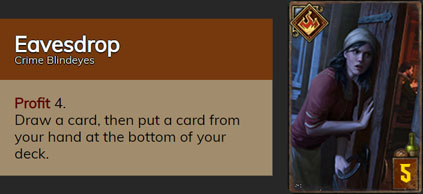 Rating: 2.5
Rating: 2.5
Eavesdrop is interesting because of hand and deck manipulation, but its low power level usually won’t justify including this card in your deck unless you are playing a heavy Crime deck which needs this kind of card to prevent unstable draws.
 Rating: 2.5
Rating: 2.5
Beggar is a solid card reminiscent of Plumard. It is only a slightly better version, as Bleeding can be Purified, while the Coins should always be translated to points and/or carryover. This card could be considered one of the bronze cores of this expansion.
 Rating: 2.0
Rating: 2.0
Blindeye Apothecary was without a doubt the most powerful bronze card in this set before the hotfix due to its combo with Whoreson's Freak Show. As this card suffered a double nerf, its great strength is gone, but it is still a decent card with a 5-point baseline, though its Tribute is more difficult to pay. The nerf to Whoreson's Freak Show is another negative factor, but this card is still playable, especially as a way to add Blindeyes to decks.
 Rating: 1.0
Rating: 1.0
Courier is the is the new Nilfgaard dual-faction bronze. Its value makes it not likely to see competitive play outside of a possible Shupe's Day Off build. While the ability to put a card on the top of the deck can combo with cards such as Cantarella or Vilgefortz, it’s not something you would like to build your deck around, considering the info about your rival is not enough reward for the lack of tempo.
 Rating: 2.0
Rating: 2.0
Line of Credit is an interesting way to get points from cards whose utility has been fulfilled. The most obvious use is Portal in combination with two Cutup Lackeys, becoming a 10-point play (at least, as with some cards, Coins can be converted into more than 1 point per Coin).
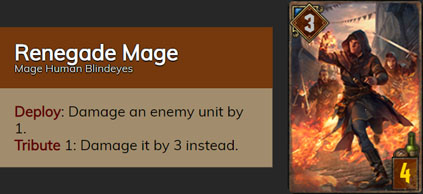 Rating: 3.0
Rating: 3.0
Renegade Mage easily fulfills the condition of being a 6-point bronze per 4 provisions, in the line of Skellige cards, which should always be the mark other factions' cards want to reach. In combination with King of Beggars, its Tribute passes from 1 Coin to 0, becoming effectively a 6-per-4 without condition, though it still sees play outside of this leader due to its potential.
 Rating: 2.0
Rating: 2.0
Sly Seductress is a solid engine which can be pulled with Portal, but whose Bonded ability is slightly worse than Cutup Lackey. Because it can be Spawned by Adriano the Mink, it is an interesting proactive engine for decks which need those extra points over time in Round 1.
 Rating: 4.0
Rating: 4.0
King of Beggars is the Tribute-oriented leader in the Syndicate faction and one of the strongest. Its passive ability makes it perfect as a base for bronze Tribute cards such as Renegade Mage, while its active makes it usable with some Coin spenders. We expect to see it as one of the good leaders of this expansion. Its decks will be the most counterable by Usurper, as most of them would be built around the passive, but still worth considering.

 Argei Rating: 4.0 | Jamedi Rating: 3.0
Argei Rating: 4.0 | Jamedi Rating: 3.0
Novigradian Justice combos with Cleaver's Muscle, providing thinning and a 10-point Shielded play for 11 provisions. It also has synergy with engines in both Syndicate and Scoia’tael (Bare-Knuckle Brawler and Dwarven Mercenary), allowing you to establish two engines on the board in much the same way as Portal. While not as overtly powerful as some of the other golds in the set, the card should see healthy amounts of play and will especially shore up ST’s Round 1 tempo and provide a safer Dwarf to stick on the board for Mahakam Volunteers.
 Rating: 2.0
Rating: 2.0
The Sausage Maker is reminiscent of Gabor Zigrin, but it is worse in almost every way. It costs 1 more provision, and its Resilience—while activatable over multiple rounds—costs a whopping 5 Coins, which is more than the 3 it initially generates. Intimidate matches up roughly equally to Gabor’s boost, but the flexibility of playing Gabor for Immunity puts Gabor well over Sausage Maker. As such, the card is largely not worth the investment. It is vulnerable to the same things a Resilient Gabor is without almost any of the upsides Gabor provides. Nonetheless, Resilience is a powerful effect, and there’s something to be said about the ability to carry over a single card for two rounds in the games where it doesn’t get Seized by Philippa Eilhart or Vigo's Muzzle first.
 Rating: 2.0
Rating: 2.0
Ferko the Sculptor continues the tradition of tutoring a specific category of special card found in other 2-point, 9-provision cards, such as Fauve and Menno Coehoorn. There are some powerful Crimes to tutor like Novigradian Justice and some engine synergy with Cutup Lackey or Intimidate, so the card has some potential. Like all tutors, the card provides thinning and consistency but doesn't add significant points to your deck. Only decks that need the consistency of finding a specific Crime every game will play this card.
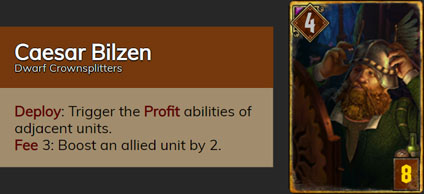 Rating: 2.0
Rating: 2.0
Caesar Bilzen has the potential to generate 9 Coins in combination with Sigi Reuven or two other Coin generators, which would be well above rate for its provision cost. However, the combo is rather fragile and relies on your opponent not killing Sigi first. Much like Vrygheff, once your opponent is clued in to your plans, it can be difficult to find value with Caesar.
 Rating: 1.5
Rating: 1.5
Harald Gord has a real deck-building cost, as most Syndicate decks currently do not play a large concentration of specials. The card breaks even with its provision cost at 5 specials, which is much to ask. To achieve great value, most of your deck’s 12 non-unit slots would have to be specials. Without 12 strong specials in the card pool, there are simply better things to be doing with those deck slots compared to trying to enable Harald.
 Rating: 3.5
Rating: 3.5
Tunnel Drill is a really solid card whose raw value and reusability makes it one of the best artifact removals in all of Gwent. At 6 points per 6 provisions, it can counter no-unit decks perfectly without posing much risk, as it still retains the flexibility of destroying an artifact as a bonus. If the rating is low, it’s more due to its niche function than its overall power.
 Rating: 3.0
Rating: 3.0
Cleaver's Muscle provides a 5-for-5 body with Shield, which is unassuming at first glance. However, this card combos nicely with Novigradian Justice, providing 10 Shielded points and thinning 1 card for 11 provisions at the cost of a 5-provision slot. In Scoia’tael, it provides Mahakam Volunteers with a tough-to-remove body in Round 1. The card is a much welcomed boost to Scoia’tael and still provides solid value for Syndicate as well.
 Rating: 2.5
Rating: 2.5
Crownsplitter Thug deals 2 damage on Deploy and leaves behind a 3-point body with Intimidate on the board for future value. The damage is definitely nice and can set up kills with other cards in the set; however, the engine portion of the card runs into similar issues as Bare-Knuckle Brawler and will receive the same rating as a result.
 Rating: 2.5
Rating: 2.5
Bare-Knuckle Brawler is a reasonable engine at a 4-points-for-4-provisions baseline. It has some synergy with Novigradian Justice and Portal, but it requires a healthy concentration of Crimes to truly excel. While most Crimes in the set are at the very least playable, holding a ton of bronze Crimes in hand Round 3 is not ideal and makes Brawler worse than, say, Lyrian Arbalest, which triggers off of almost every card in the King Henselt deck.
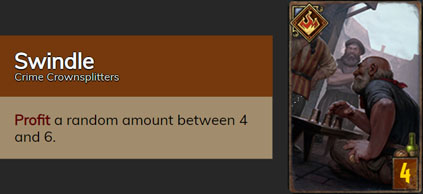 Rating: 3.5
Rating: 3.5
Swindle is an excellent card in Hoard decks which let you play proactively without risking much, forcing your opponent to play proactively as you are not putting points on the board. Randomness is a downside.
 Rating: 2.0
Rating: 2.0
Cleaver's leader ability reminds of Dana Méadbh or Jan Calveit, but with a more significant deckbuilding constraint if you want to fetch powerful specials like Shupe's Day Off or Renew. While the ability offers consistency in finding your gold specials, there will always be a sizable number of games where you draw all your high-provision specials naturally, causing Cleaver to more or less brick and fetch a low-impact bronze. Due to this liability, Cleaver is a step down from the other Syndicate leaders in power level.

 Rating: 2.5
Rating: 2.5
Igor the Hook has difficulty getting real value due to its high provision cost, which, added to the high Fee cost, makes this card unattractive. If we also consider that the card we want to copy (preferably an engine) needs to stick around for one turn, we have the ingredients for a low-playrate gold card. Still, if somebody is able to discover a crazy combo with this card, we don’t doubt it can see some play.
 Argei Rating: 3.0 | Jamedi Rating: 2.5
Argei Rating: 3.0 | Jamedi Rating: 2.5
Whoreson Senior is designed around paying its Tribute due to the Bonded ability of Cutup Lackeys, which increases its cost significantly (or lowers its point output). The requirement of having two units in the same row makes it perfect for a Cyrus Hemmelfart deck with its leader's token-generating ability. During these first days of the patch, it has seen some play, and if Crimes are good cards in general, we expect its playrate to rise.
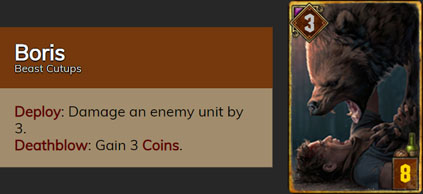 Rating: 4.0
Rating: 4.0
Boris is a pretty solid card. In combination with other removal-oriented cards in this set, it has a Deathblow that is easy to trigger, becoming a solid 9-point card for 8 provisions. There is not much more to analyze due to its simplicity, it is just a card that is close to an auto-include in every deck which runs the Bounty package or Whoreson's Freak Show.
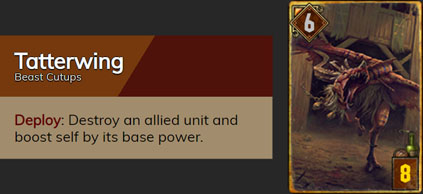 Rating: 3.0
Rating: 3.0
Tatterwing is playable in most Deathwish decks as an activator, possibly comboing with Caranthir Ar-Feiniel for example, suggesting a niche in Arachas Queen lists. Meanwhile, in Syndicate, this card can be used to eat The Flying Redanian, getting a free 4 points from this card, while being also useful, for example, to eliminate a Whoreson's Freak Show which can’t generate more value.
 Rating: 3.5
Rating: 3.5
Pugo Boom-Breaker will fill the spot left in Big Monsters decks by Count Caldwell and Golyat after their respective nerfs. While the most obvious combo is with Gernichora, just Spawning Gernichora's Fruit to play Pugo for a value of 10 points, it can see some niche play as a Deathwish activator in some decks and as tempo play in Arachas Queen decks, where it can be used as an effective 11-point play (if we count the Arachas Drones).
 Rating: 2.5
Rating: 2.5
Whoreson's Freak Show was the star card of this set before the hotfix nerf; it is still playable after the nerf, but no longer spectacular. Its ability to pay 1 Coin to cause 1 Bleeding on an opponent unit may not shine too much on its own, but it also has an Insanity ability that deals 1 random damage for each point of Insanity damage taken. This provides the card with the utility to delete Immune units, which was previously one of the weaknesses of the faction. This is still a card which synergizes very well with boosts and Heals, but it is not as much of an auto-include as before the hotfix.
 Rating: 2.0
Rating: 2.0
Wheel of Fortune, despite being a playable card in Constructed, has a horrible design which we would like to see changed. It is too variable in value, but playable on red coin with the possibility of highrolling it, which will always result in a feels-bad sensation for one of the players. Due to its low provision cost, we can expect this card to see some play in Constructed.
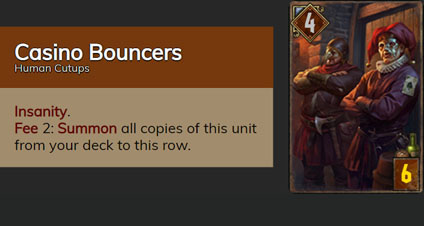 Rating: 3.5
Rating: 3.5
Casino Bouncers is a card with straightforward value: It represents 6 points plus unconditional thinning when using its Insanity ability. If you have 2 Coins available to play its Fee 2 ability, then it's 8 points of tempo with exactly the same end result, unless you are playing against some kind of Bloodthirst deck. Despite the obvious usefulness of thinning, it has been outshone to date by Sewer Raiders, due to the relative ease of meeting that card’s condition.
 Rating: 2.0
Rating: 2.0
Arena Endrega seems to be a more flexible printing of Dimun Light Longship. Similar to that card, it is able to do damage by draining its own life total (using the Insanity keyword), but it can also spend Coins to do damage instead of its own life. Despite not offering great value, it could see play as an enabling card to align certain Deathblows or as a way to sink single Coins, which is not common among most of the Coin spenders.
 Rating: 2.0
Rating: 2.0
Arena Ghoul is a mediocre card compared to the rest of Syndicate bronzes. A value of 5 points (as we have to discount the 2 Coins we pay from the Tribute) is not impressive for a 5-provision card. Even playing this card with King of Beggars only makes it worth 6 points for 5 provisions, which is still under the line to be playable in this faction, due to the high competition among Syndicate bronzes.
 Rating: 3.0
Rating: 3.0
Payday is the counterpart of Primal Savagery, but it generates 5 Coins instead of 5 points. While not immediately impacting the board, this is a benefit because Coins are non-interactable for our opponents, are flexible in their use, and can sometimes get more than 1 point per Coin. At first it may seem that Deathblows are difficult to play in Syndicate, but we have enough tools in the faction to align this card with few problems.
 Rating: 1.0
Rating: 1.0
Bloody Good Fun competes for the title of worst card in the set. While its design resembles Imlerith's Wrath, it is powered by Coins and, in most scenarios, forcing the player to waste all of them just to deal that amount of damage seems to be a little bit overkill. Having something different in the text, such as “only lose Coins if you don’t kill the enemy unit”, could make this card playable.
 Rating: 3.0
Rating: 3.0
Cutup Lackey is one of the stronger bronze engines in this set. Its Bonded ability makes it perfectly suitable to be combined with Portal, as we can just fill the other 4-provision spots with Crime cards to synergize with this card. As a result, this is probably one of the best Bonded abilities in the game, and a really solid bronze card to be used as the core of a Crime-based archetype.
 Rating: 3.5
Rating: 3.5
Kikimore Warrior is a solid card which can see play in different Monsters decks, including Arachas Queen or Gernichora. Due to the nerf to Gimpy Gerwin, this card can be used as a 3-point-per-turn engine in Arachas Queen, an appreciable value considering that it is a 4-provision engine.
 Argei Rating: 3.5 | Jamedi Rating: 3.0
Argei Rating: 3.5 | Jamedi Rating: 3.0
Whoreson Junior, the Cutups leader, at first sight seems to be a weaker leader in comparison to the other leaders of the expansion, but it has a key characteristic which makes it good: flexibility. When activating Whoreson, you can use the damage to remove whatever you need while gaining the remaining damage as Coins. This makes Whoreson a great leader if you want to make a deck centered around the Bounty keyword or a control gameplan.

 Rating: 2.5
Rating: 2.5
Grand Inquisitor Helveed is a Coin spender that swarms the board with tokens. While the card has Firesworn synergy with Sacred Flame and Procession of Penance, it plays below rate for its provision cost, only giving 4 points and 4 Coins. As such, the card will see play in Firesworn Swarm lists but probably not in anything else.
 Rating: 1.5
Rating: 1.5
Prophet Lebioda can protect engines in both Northern Realms and Syndicate, serving as a weaker but repeatable Avallac'h. Regrettably, at 6 power for 10 provisions, the card is quite a bit overcosted and easily answered by a Lock. It doesn’t take a prophet to see that this card won’t see much play in such a control-heavy meta.
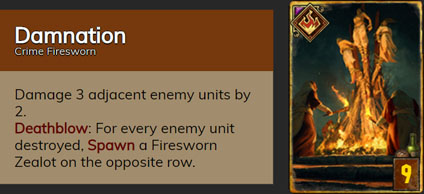 Rating: 2.5
Rating: 2.5
Damnation promises up to a 12-point swing, but it has a finicky setup. With the nerf to Whoreson's Freak Show, the setup is even harder and is especially weak in short rounds. However, even getting off 1 Deathblow on a row of 3 gives a reasonable—if unexciting—8 points. While the payoff is above rate, the unreliable setup and weakness in shorter rounds lowers the rating a bit.
 Rating: 3.0
Rating: 3.0
Nathaniel Pastodi gets its provisions in value fairly reliably, only needing 1 boost to do so. The card can potentially be a powerful engine in decks like Queen Meve that have access to multiple boosts. However, Bleeding is significantly worse than direct damage. Nonetheless, it’s fairly easy to play Nathaniel above provision rate. If Meve ever shows up in the meta again, Nathaniel will likely show up too.
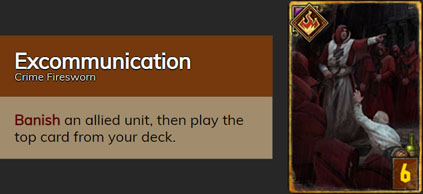 Rating: 1.0
Rating: 1.0
Excommunication is a trap. On the surface, the card resembles Prince Villem, which sees fringe play. The top of the deck is much worse than a random gold, and Banishing a unit is a very real setup cost. Even comboing with Fisher King is underwhelming, as it requires a 4-point card on top of Banishing a unit to fetch any card in your deck—2 cards and 13 provisions later, you have the world’s worst Royal Decree.
 Rating: 3.5
Rating: 3.5
Procession of Penance is a massive 10 points for 6 provisions if you meet its setup cost. In the swarm deck, finding 6 Firesworn Zealots isn’t hard to do: Congregation with Cyrus Hemmelfart's leader ability is enough. The card is a solid payoff for its archetype.
 Rating: 3.0
Rating: 3.0
Congregation provides 6 points over 3 bodies for 6 provisions. While unexciting by itself, the card combos nicely with Sacred Flame and Procession of Penance, and it is a decent option for Sigi Reuven to fulfill the Firesworn gang requirement. Coin carryover can make the card a little awkward if you don’t have a great way to spend the leftover Coins, but planning ahead can alleviate some of the clunkiness.
 Rating: 2.0
Rating: 2.0
Eternal Fire Inquisitor plays as 6 points for 5 provisions if you hit the Deathblow—not particularly impressive for the setup cost. The swarm deck doesn’t want the card, as it doesn’t play that much damage to align the Deathblow, and most other decks would prefer to run something more reliable or just downgrade the slot to one of the many solid 4-provision cards in the set.
 Rating: 2.0
Rating: 2.0
Firesworn Scribe combos with Grand Inquisitor Helveed to generate 2 points per Coin and with Igor the Hook to fill up a row with Scribes. Both combos are vulnerable to removal and rather space-intensive, but they can potentially win games if left unanswered. Outside of the two combos, the card is thoroughly unimpressive, starting at 3 power and providing Coins in an archetype that traditionally doesn’t want that much Coin generation.
 Rating: 1.5
Rating: 1.5
Keeper of the Flame compares poorly to its fellow swarm payoff Procession of Penance. A 5-points-for-5-provisions base isn’t great compared to other cards in this faction, and the setup for full value requires an 8-unit row and 4 Coins… only to net 7 points after subtracting the Tribute cost. Keep this one away from your swarm decks.
 Rating: 1.5
Rating: 1.5
Eternal Fire Disciple is severely limited by its Cooldown, making what would be a decent Coin spender into a rather anemic lightning rod for removal. At 2 power, the card is more Deathblow bait than Coin spender, usually only netting 4 points. Even the swarm synergy isn’t quite enough to rescue the card; there are simply better 4-provision bronzes to play in this faction.
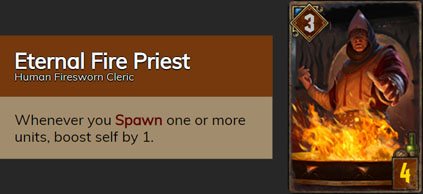 Rating: 1.5
Rating: 1.5
Eternal Fire Priest is a mediocre swarm engine with some limited synergy with Cyrus Hemmelfart's leader ability and Grand Inquisitor Helveed to grow multiple times per turn. Note that cards that Spawn multiple units like Congregation will only grow the card by 1 point. Sadly, starting at 3 power is substantially worse than 4 for a 4-provision engine and makes the card more vulnerable to removal, limiting its effectiveness.
 Rating: 2.0
Rating: 2.0
Temple Guard is a fairly reliable 5 points for 4 provisions, which is fine but not flashy. You’re never thrilled to play the card, but you might slot it in if you need another 4-provision card and don’t want to mess around with engines or fancy setups.
 Rating: 3.5
Rating: 3.5
Cyrus Hemmelfart nets 8 points over 3 bodies and 2 Coins and is the obvious choice for the swarm deck. Having 3 Charges means flexibility in early rounds if you need a couple of points, but you’re more than happy to drop a Sacred Flame and all 3 Charges in Round 3 for a neat 11 points. In a vacuum, Hemmelfart is a solid leader with a relatively powerful ability with swarm synergy. Sadly, the swarm archetype is just a notch weaker than other decks in the faction, so the leader score is adjusted accordingly.

 Rating: 4.0
Rating: 4.0
Bincy Blumerholdt is an adorable Halfling which has become a popular card this expansion due to several factors. In particular, it is strong against the Bounty mechanic, and when there is not that much tall removal in the meta. It combos powerfully with Gudrun Bjornsdottir. Overall, it is a solid card whose value is slightly better than other cards of this style, such as Dagur Two Blades in Harald the Cripple decks.
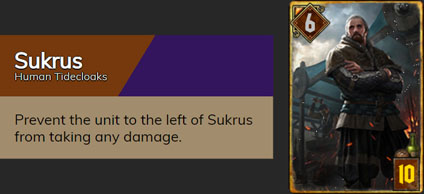 Rating: 1.5
Rating: 1.5
Sukrus is one of the dual-faction cards with Skellige, but its function there is already fulfilled by Heymaey Protectors. Additionally, Skellige actually benefits from self-damage in a number of scenarios. It is also necessary to note that Sukrus has anti-synergy with Insanity, as preventing the damage causes Insanity not to proc. It doesn’t look like a card whose playrate will be better than low during the first months of the expansion.
 Rating: 2.0
Rating: 2.0
Hvitr and Aelydia is an interesting engine-based in the mechanic of Hoard, and whose design resembles a less risky version of Sigvald. The downside is exactly the same one that the Skellige card presents, as these kinds of engines are much better in decks focused on playing a lot of engines, which are not really favored in this faction. Due to this, we can’t give this card a better score, despite having great potential if unanswered.
 Rating: 3.0
Rating: 3.0
Imke is an interesting Coin-generation engine, which can protect itself from damage if necessary with its Fee ability. It can be used to create a constant source of Coins to enable different kinds of spender cards, such as Ewald Borsodi or Caleb Menge. While it is a good card, it is an engine in a faction whose principal strength is not being dependent on engines.
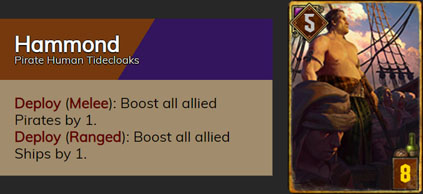 Rating: 1.0
Rating: 1.0
Hammond is a card whose purpose is to support an archetype, Pirates and Boats, which is still lacking enough valuable cards to be playable. As a consequence, we don’t think this card can realize its potential in its current form or with the current card pool, becoming a sleeper until the pool becomes wider.
 Argei Rating: 1.5 | Jamedi Rating: 2.0
Argei Rating: 1.5 | Jamedi Rating: 2.0
Tavern Brawl is a card which resembles the old pre-Homecoming Nilfgaard card Treason. While it can get decent value, its high provision cost makes it reasonably unattractive to play. It is just too easy to play around, and thus is mostly a cheesy card which can punish some players on ladder if they are caught unprepared.
 Argei Rating: 2.5 | Jamedi Rating: 2.0
Argei Rating: 2.5 | Jamedi Rating: 2.0
Dip in the Pontar mirrors Shakedown, but damaging instead of boosting. Despite damage being generally better than a boost of the same value since Homecoming, a 6-point card for 5 provisions is not really something to brag about in Syndicate. However, it can be played with some synergy in certain Crime decks.
 Rating: 4.0
Rating: 4.0
Sewer Raiders, the other bronze thinner in this set, is relatively similar to other 5-provision thinners, such as Mahakam Volunteers or Brokilon Sentinels. It offers cost-effective thinning if certain conditions are fulfilled; in this case, having a Hoard of 4 Coins. In combination with cards as Swindle, this requirement is generally easy to fulfill for Syndicate, making this card almost auto-include in any Syndicate deck which generates Coins.
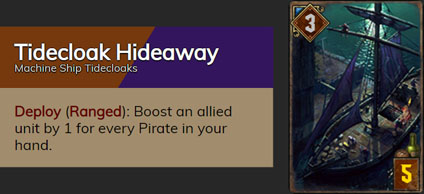 Rating: 1.5
Rating: 1.5
Tidecloak Hideaway, the third Syndicate card shared with Skellige, is meant to support the archetype of Pirates and Boats. The problematic thing with its design is the current lack of other Pirates to support this archetype, making this card not good enough to see play unless the pool becomes wider to include further Pirates.
 Rating: 1.0
Rating: 1.0
Eventide Plunder would be a reasonable card if Tunnel Drill didn’t exist in the set. With Tunnel Drill as such a versatile and powerful answer to artifacts, however, there is little reason to play a slightly more flexible but still rather mediocre Dimeritium Bomb.
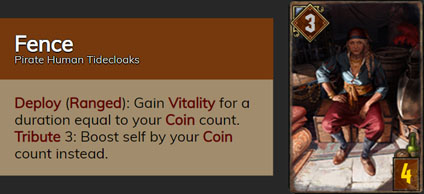 Rating: 4.0
Rating: 4.0
Fence is another of the bronze stars of this set. While its value is relatively conditional on the success on your Coins generation, this card can easily provide 7 or 8 points (after paying the Tribute), which is a superb quantity for a 4-provision bronze. Overall, it is a great card which can be included in any Syndicate decks with enough Coin-generation capability.
 Rating: 3.0
Rating: 3.0
Sea Jackal, another of the bronze Coin spenders, offers a Hoard ability which is able to overcome the standard 1:1 rate conversion between Coins and points. Due to this, it is an interesting play in some decks, especially one that is easily able to reach the cap of 9 Coins. Despite being punished by tall removal due to being a boosted unit, it is strong against the Bounty keyword, which is currently one of the strongest mechanics in Syndicate.
 Rating: 2.5
Rating: 2.5
Tidecloak Ransackers is a card whose brightness is obscured by the other Syndicate 4-provision cards. It is not a bad card in and of itself: A conditional 6 points for 4 provisions, which can be assured by fulfilling the Hoard 5 requirement, seems to be an acceptable level for bronze cards. It’s currently just not quite good enough in Syndicate.
 Rating: 4.0
Rating: 4.0
Gudrun Bjornsdottir has become the strongest leader of the expansion. Its own value per se is quite high, but due to its flexibility, it is the perfect leader for any Syndicate deck utilizing Coins, while also being able to protect an engine or a spender if needed. Overall, Gudrun is a solid leader whose provision cap is not too high, but still high enough to be considered as the best leader in Syndicate.

 Rating: 3.0
Rating: 3.0
Graden by itself is a solid card, able to cash in well above rate with a Bounty giver. However, the existence of damage options like Witch Hunter Executioner means that you are often not lacking in ways to kill a Bounty, making the costly 9-provision Graden somewhat redundant. Nonetheless, the card has niche use against units too big to be removed by Coin spenders if you can spare the provisions.
 Rating: 4.0
Rating: 4.0
Moreelse is a flexible damage card, able to handle tall units and engines alike. While it’s hard to get above provision rate with the card, requiring a 12-point unit or bigger after accounting for Tribute costs, getting 4 damage and a 4-power body for 9 provisions is a very respectable baseline. The card is reminiscent of pre-nerf Regis and Enraged Ifrit combined with a potent (but expensive) Tribute option.
 Rating: 3.5
Rating: 3.5
Caleb Menge was an extremely powerful Bounty enabler pre-nerf, able to tag most of the board in one turn. With a Cooldown, the card is still strong but much more fair, allowing the opponent to Lock or remove it before it gets out of control. In combination with Witch Hunter Executioner or Ewald Borsodi, Menge allows you to remove any unit for 3 Coins. This lets the card trade above rate with a relatively easy setup.
 Rating: 1.5
Rating: 1.5
Kurt is flexible but not much else. While Lock and Purify are nice and Intimidate might give marginal value every now and then, 8 provisions is a ridiculously high cost to pay for that effect. Adalbertus Kalkstein plays at rate for its provision cost if Purify is important, and there are better ways to deal with engines than a severely below-rate Witch Hunter who’s far less intimidating than the card text implies.
 Rating: 1.5
Rating: 1.5
Tamara Strenger scales with the number of playable Witch Hunters in the faction. Unfortunately, while the Bounty package is powerful, there just aren’t enough Witch Hunters to justify Tamara’s inclusion. If strong Witch Hunters are printed in future expansions and a more dedicated Witch Hunter deck emerges, Tamara could be a powerful point swing, but for now, you’ll often be working very hard to just break even with the card.
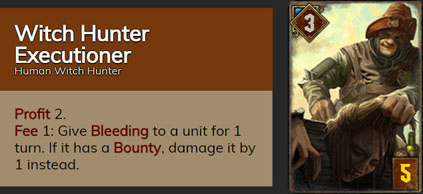 Rating: 4.0
Rating: 4.0
Witch Hunter Executioner is one of the go-to finishers of the Bounty deck, able to quickly machine-gun down a board of Bounties, replacing the Coins spent with each kill. Without Bounties, the card plays as a 5 points for 5 provisions, an acceptable baseline for such a potent effect. Though the card itself technically does not trade up, it allows cards like Witch Hunter to get 9 or 10 points of value, easily justifying its inclusion in any deck with Bounties.
 Rating: 4.5
Rating: 4.5
Witch Hunter is the most efficient Bounty giver, getting a full 4 power for 4 provisions in addition to the Bounty effect. This allows the card to trade up for ridiculous value even by just tagging a 4- or 5-power unit. Cashing in on the Bounty is fairly easy with Witch Hunter Executioner or any other damage source. Witch Hunter is the strongest bronze in the set, hitting well above its provision cost.

 Rating: 4.5
Rating: 4.5
Sigi Reuven is still a very strong card after the hotfix, getting 12 points for 13 provisions. The 9-Coin burst is one of the easiest ways to thin The Flying Redanian from the deck, while also being the perfect card to generate a lot of tempo with other Coin spenders. Adding 5 unique gang tag cards to a deck generally isn’t very difficult, making the deckbuilding constraint relatively minor. Its value is remarkable through the deck builder alone, but it also has the possibility of increasing its value due to its Intimidate ability. Other possible combos with it include Caesar Bilzen, which triggers its increased Profit, making it an excellent card in decks that can translate these Coins into points.
 Rating: 3.0
Rating: 3.0
Sacred Flame is the marquee card for the swarm archetype, offering 6 points immediately and promising substantial future value. While it takes 5 additional Spawns to reach its provision cost in points, cards like Congregation and Cyrus Hemmelfart's leader ability can close the gap rapidly. The card is able to generate a significant amount of points in a longer round, but weaknesses to artifact removal and bleeding, as well as the somewhat lower power level of the swarm deck in general, detract from Sacred Flame’s overall rating.
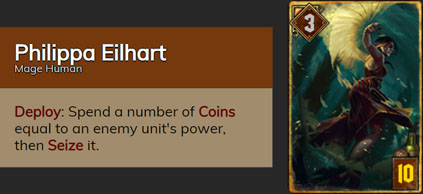 Argei Rating: 4.0 | Jamedi Rating: 3.5
Argei Rating: 4.0 | Jamedi Rating: 3.5
Philippa Eilhart is one of the stars of the set. Unfortunately, it is difficult to achieve its value in provisions, as we have to keep in mind that every Coin paid in-game equals playing a more expensive card. Stealing a 4-point card is roughly the threshold for a decent trade in provision points, while also having the additional benefit of being able to Seize engines without Locking them (unlike Vigo's Muzzle, a similar card).
 Rating: 4.0
Rating: 4.0
The Flying Redanian has become one of the most popular cards of the expansion due to its good characteristics: tempo, thinning, and relative easiness to proc multiple times. While it can be countered by cards like Regis: Bloodlust or Vigo's Muzzle, it is a sort of Roach for Syndicate, grating tempo, and can be triggered additional times if sent to the graveyard.
 Rating: 1.5
Rating: 1.5
Vivaldi Bank looks clever on paper, but in practice will play as a worse Royal Decree most of the time. Sure, it’s nice to fetch any card in your deck Round 3 with a full bank, but unless the card you want is near the top of the deck, you can end up paying an awful lot for what amounts to inconsistent thinning. I would look to invest my provisions elsewhere.
 Rating: 4.0
Rating: 4.0
Ewald Borsodi, by virtue of doing damage instead of boosting, is generally going to be the better of the two brothers. Being able to remove engines or cash in on Bounties makes Ewald an excellent control tool and warrants the higher rating despite everything else being equal.
 Rating: 3.0
Rating: 3.0
Horst Borsodi and his brother Ewald Borsodi are a Coin-spending combo, mirroring each other’s effects. With a provision cost nerf and a nerf to Whoreson's Freak Show, the card is nowhere near its release-day strength. In spite of that, Horst is still a reasonable way to spend your Coins, or at the very least, can set up a strong Ewald in Round 3.
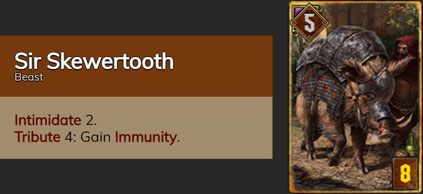 Rating: 2.0
Rating: 2.0
Sir Skewertooth is an engine designed to be played in combination with some Crimes, as it gets 2 additional points every time you play one of that category. As it plays into tall removal, paying its Tribute is recommended, making it a card whose cost is steep unless you play more than 3 Crimses. Skewertooth can fit into some decks, but we don’t expect it to be the most popular card.
 Rating: 1.0
Rating: 1.0
Townsfolk is without a doubt the worst engine in the set. At 4 power for 6 provisions, the card requires two procs to just break even and, on top of that, has a rather unreliable trigger condition. There’s some synergy with Tax Collector and Imke, but relying on engines surviving multiple turns just for a 6-provision card to get any value seems like a losing proposition.
 Rating: 3.5
Rating: 3.5
Coerced Blacksmith, though unassuming at first, is one of the better Coin spenders this set. Unlike the more common 2-Coin spenders like Horst Borsodi, Blacksmith can spend single Coins which might otherwise go to waste. It gains additional value as a soft counter to Bounty decks by boosting units out of range or just forcing much greater Coin expenditure to kill a unit, leaving less Coin for Menge to tag and kill additional targets.
 Rating: 2.5
Rating: 2.5
Halfling Safecracker is Syndicate’s version of Venendal Elite, breaking even with just 1 Crime in hand. Still, 5 points for 5 provisions is rather underwhelming in this faction, so this card will only be viable in Crime-heavy decks. Should such an archetype arise, the card would be a solid inclusion, but as it currently stands, Safecracker is a build-around without a great shell.
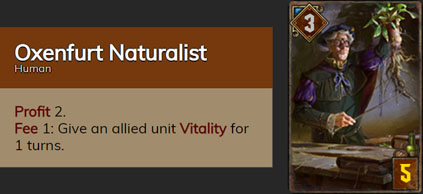 Rating: 2.0
Rating: 2.0
Oxenfurt Naturalist seems awfully silly with Coerced Blacksmith in the same set. While not strictly worse, as the 2 Coins generated could be used for other purposes, Vitality is significantly worse than straight boost. Naturalist isn’t necessarily a terrible card, but will always be overshadowed by its metalworking cousin.
 Rating: 3.0
Rating: 3.0
Tax Collector is one of the better engines in the set, in stark contrast to Townsfolk. The card ticks for value immediately upon being played, getting a guaranteed 5-for-5, and doesn’t need an outside trigger condition to continue gaining value. At 4 power, Tax Collector is especially nice in Round 1, when the opponent might not want to spend a high-value gold card to answer a 5-provision bronze.
 Rating: 3.0
Rating: 3.0
Back-Alley Chemist is another niche card designed to be played in self-Poisoning decks, being a solid 6-point value for 4 provisions while activating Wretched Addict. Interesting design, a strong example on how 4-provision cards should look.
 Rating: 2.0
Rating: 2.0
Fisstech is, as with most Poison cards, too slow. Despite that, we can consider the possibility of making some kind of self-Poisoning deck with Wretched Addicts in it, using Summoning Circle as a way to combo them. However, there are still better cards to do that, such as Fisstech Trafficker or Back-Alley Chemist.
 Rating: 2.0
Rating: 2.0
Fisstech Trafficker is a niche card whose main purpose is to be played in self-Poisoning decks, as we can get a decent 5-point value using it. It’s also able to activate an engine such as Wretched Addict. Despite having an interesting design, its power level isn’t great. It is an alternative which plays better around tall removal than Back-Alley Chemist.
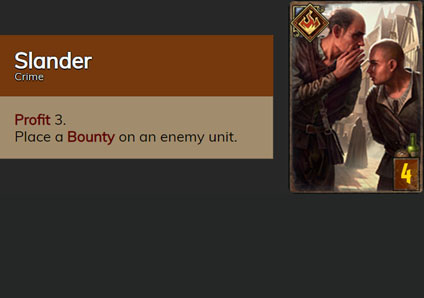 Rating: 3.5
Rating: 3.5
Slander has the powerful Bounty keyword, which, when paired with a damage source, can represent a relatively reliable 7 or more points (assuming that the Bounty is placed on a 4-power card or greater). This is an amazing amount of points for a bronze and makes Slander one of the more powerful Crimes. However, the Bounty package usually has enough sources of Bounty between Caleb Menge and Witch Hunters and it is not always easy to spend the Coin attached to the card efficiently if you are saving your spenders as finishers. As Witch Hunters are going to be better than Slander, the card is rated lower, despite its power level.
 Rating: 3.0
Rating: 3.0
Wretched Addict is a nice engine designed to be played in combination with one of the cards noted above, such as Fisstech Trafficker if we prefer to get Coins or Back-Alley Chemist if we prefer direct points, while playing dangerously into tall removal. Despite that, it is an interesting card for being a 4-provision filler.
Editing: Callonetta, Kochua, lordgort, SwanDive. Website: Argeiphontes, SwanDive.

Author
Argeiphontes
Argeiphontes is a long-time card game player starting with Magic: The Gathering over a decade ago. In that time, he has played Magic, Hearthstone, Eternal, and of course Gwent at a competitive level at varying points in time. With a Top 3 finish at Wild Hunt 2 and consistent Top 100 Pro Ladder finishes, he hopes to continue improving at the top level of the game. While Argeiphontes will continue streaming and sharpening his competitive skills, his main focus on the team will be producing educational content, with a focus on deep diving core Gwent gameplay concepts. He looks forward to growing with the team and the game.



